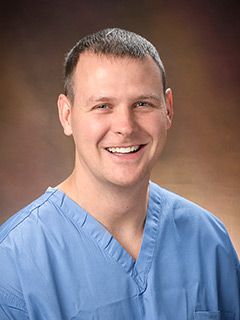HOW CAN WE HELP YOU? Call 1-800-TRY-CHOP
In This Section
‘Catalytic Funding’ Establishes the Topolewski Pediatric Heart Valve Center
Cora Topolewski was born in the Special Delivery Unit at Children’s Hospital of Philadelphia with multiple heart defects. Four days after her birth, Stephanie Fuller, MD, performed a lifesaving open heart surgery to fix the hole in her heart wall, as well as her narrow aortic arch. Days after, the Topoleswki’s came home with their newborn.
Cora’s medical team decided they would wait to treat her aortic valve — which was causing blood from her left ventricle to leak back into her main heart chamber — until she was older and bigger. Valve repair can be particularly complicated in newborns, and even for those who have their valves replaced, they will likely need additional surgeries as they grow.
A few weeks later, Cora went into heart failure and was rushed to CHOP’s Emergency Department. She was then transferred to the Cardiac Intensive Care Unit (CICU), where she received a successful balloon valvuloplasty catheterization procedure by Michael O’Byrne, MD, MSCE. Four years later, Cora hasn’t required any additional interventions as she enjoys a healthy, normal life.
“It was a very scary time,” Cora’s mother, Kristin Topolewski, said. “We felt so grateful to CHOP that we could bring Cora back home relatively healthy. But to know that many other children were still sick in the CICU, it was humbling.”
After that experience, she and her husband Ed Topolewski felt compelled to give back: The family established the Cora Topolewski Cardiac Research Fund at CHOP, which has supported the Cardiac Center and research projects within the Pediatric Heart Valve Center, a 2021 Frontier program.
Now, a new, multimillion-dollar gift from the Topolewskis will further advance both clinical and basic science research at CHOP that is finding new solutions for kids like Cora with complex heart valve diseases. The gift will establish the Topolewski Pediatric Heart Valve Center as well as the inaugural Topolewski Endowed Chair in Pediatric Cardiology, which will be held by Matthew Jolley, MD, an attending physician in pediatric cardiac anesthesia and echocardiography.
In addition to Dr. Jolley’s research, which uses 3D image-based computer modeling to inform surgical and interventional planning in children with heart abnormalities, the funding also will help to support other projects, including minimally invasive techniques, innovations in imaging, and therapeutics. CHOP’s director of Cardiology Research Robert Levy, MD, for example, is studying why bioprosthetic valves deteriorate over time and the medications that can be used to preserve them.
“Heart valve abnormalities are very common in children, and yet, they can be some of the most challenging disorders to treat,” said Joseph Rossano, MD, MS, FAAP, FACC, co-director of the Cardiac Center and chief of the Division of Cardiology at CHOP. “Having better models of these diseases and understanding the mechanisms that are leading to valve failure will have a profound impact on how we treat these patients.”
SlicerHeart Platform Informs Valve Repair
When thinking about “precision medicine,” techniques like genome sequencing and cell therapies may come to mind. However, in Dr. Jolley’s laboratory, it is innovations in imagingthat are paving the way for patient-specific interventions.
3D imaging, Dr. Jolley said, is critical to understanding and treating cardiovascular disease, but there have been few tools to date that allow clinicians to analyze 3D imaging data, particularly in pediatric patient populations.
Researchers in Dr. Matthew Jolley's lab are using 3-dimensional imaging and modeling to enhance preoperative surgical planning for complex truncal valve repair. (Williams et al, Circulation: Cardiovascular Imaging, 2022)
“Historically, a surgeon only had a 2D echo image, and they are limited by what they can see in the operating room,” Dr. Jolley said. “They have limited time, and each time they try to repair the valve, and are unsuccessful, they are damaging it to some degree.”
SlicerHeart is an open-source computing platform created in Dr. Jolley’s lab that helps to inform valve repair and other interventions in congenital heart disease. The platform (an extension for open-source 3D Slicer software) allows medical teams to import 3D images and create a custom model of a child’s heart, as well as a highly customized approach to intervention. Dr. Jolley and his research team also are developing computational simulations to assess how well specific patients will respond to certain surgeries.
“If you have the best images and the best simulations, then you can decide what your best options are before you go to the operating room,” Dr. Jolley said.
The availability of SlicerHeart has been a game-changer for Jonathan Chen, MD, co-director of the Cardiac Center.
“Dr. Jolley’s work has really revolutionized our preoperative planning, particularly when it comes to the aortic valve repairs,” Dr. Chen said.
The gift from the Topolewski family is “catalytic funding,” Dr. Jolley said, that will support new “rising stars” in the cardiac field, as well as innovative research projects that government funding agencies may be less inclined to support with research grants.
“If you give really smart people the ‘why’ that comes with walking into a children’s hospital, and combine that with funds to support them, then they want to be here and amazing innovation will happen,” Dr. Jolley said. “This funding allows us to extend into domains that we otherwise would not be able to explore.”


